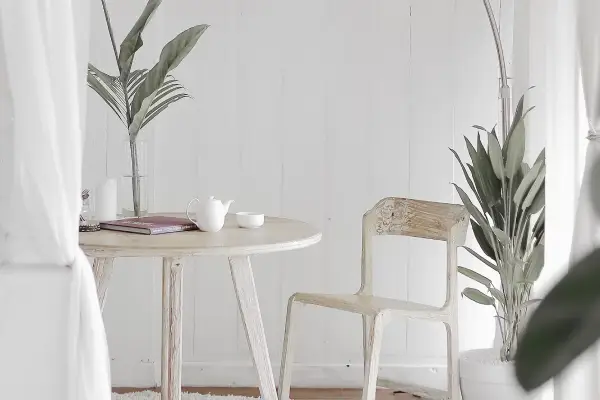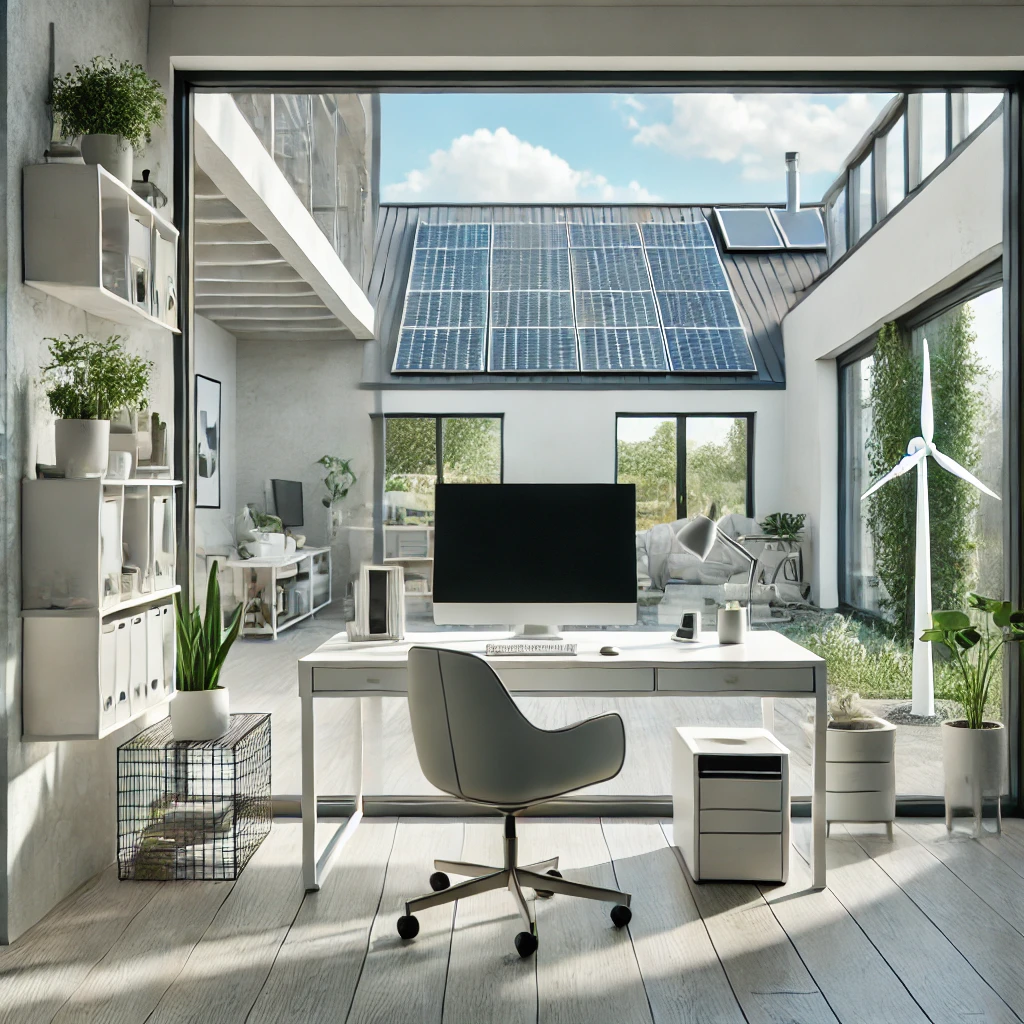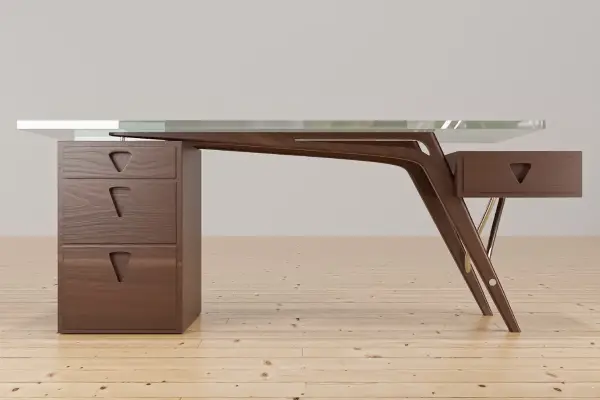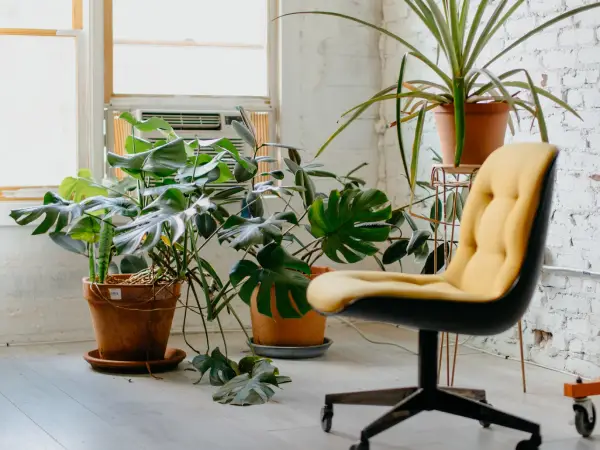Incorporating natural elements into interior design has become increasingly popular, particularly in home office setups. As more people seek to create a work environment that is not only functional but also serene and inviting, the use of natural elements in minimalist decor has gained significant traction. This trend combines the best of both worlds: the simplicity and clean lines of minimalism with the warmth and tranquility of nature.
The purpose of this article is to guide you on how to seamlessly integrate natural elements into your minimalist office decor. Whether you’re setting up a new workspace or looking to revamp an existing one, incorporating these elements can enhance the overall aesthetic and create a more pleasant working environment.
Using natural elements in your minimalist office can transform it from a purely functional space into a haven of calm and productivity. Natural materials, greenery, and earth-toned color palettes not only add visual appeal but also contribute to a healthier and more balanced workspace. Let’s explore the key strategies and decor pieces that will help you achieve this harmonious blend of minimalism and nature in your home office.
The Benefits of Natural Elements in Minimalist Design
Improved Well-being: Integrating natural elements into your minimalist office design can significantly enhance your well-being. Studies have shown that exposure to natural materials and greenery can reduce stress, improve mood, and increase overall productivity. Natural elements create a calming atmosphere that helps to balance the often stark and impersonal nature of minimalist decor. This balance is crucial for creating a workspace that not only looks good but also feels good to be in.
Enhanced Aesthetic: Natural elements add warmth, texture, and visual interest to minimalist spaces. While minimalism emphasizes simplicity and functionality, incorporating materials like wood, stone, and natural fibers can prevent the space from feeling too sterile or cold. The organic shapes and varied textures of natural elements provide a pleasing contrast to the clean lines and uncluttered surfaces typical of minimalist design, creating a more inviting and dynamic environment.
Sustainability: Using natural elements in your office decor is not just about aesthetics; it’s also about making environmentally conscious choices. Natural materials are often more sustainable than synthetic alternatives, reducing your environmental footprint. For example, choosing furniture made from sustainably sourced wood or opting for organic textiles can contribute to a more eco-friendly office setup. This commitment to sustainability aligns with the minimalist principle of mindful consumption, where quality and longevity are prioritized over quantity.
Incorporating natural elements into your minimalist office design offers a multitude of benefits, from enhancing your well-being and aesthetic appeal to promoting sustainability. By carefully selecting and integrating these elements, you can create a workspace that is both functional and inspiring, fostering a more productive and enjoyable work environment.
Natural Materials for Furniture
Wooden Furniture
Wood is a versatile and timeless material that perfectly complements minimalist design. Its natural grain and warm tones add a touch of nature to your office, creating a more inviting and cozy atmosphere. When selecting wooden furniture for a minimalist office, look for pieces with clean lines, simple silhouettes, and minimal ornamentation.
Suggestions:
Desks: Choose a wooden desk with a sleek, streamlined design. Options like a solid oak or walnut desk can provide a sturdy and elegant workspace. Consider desks with built-in storage to keep clutter at bay while maintaining a minimalist look.
Chairs: Wooden chairs with ergonomic features can offer both comfort and style. Look for chairs with simple designs and natural finishes that complement the overall aesthetic of your office.
Shelves: Floating wooden shelves are an excellent addition to a minimalist office. They provide storage without taking up floor space and add a touch of natural beauty to your walls.
Stone and Marble Accents
Incorporating stone and marble accents can bring a sense of luxury and sophistication to your minimalist office. These materials are not only durable but also add a unique texture and visual interest to the space. When used sparingly, stone and marble can enhance the minimalist aesthetic without overpowering it.
Suggestions:
Tabletops: A stone or marble tabletop can serve as a striking focal point in your office. Look for desks or tables with a polished marble surface or a stone inlay to add a touch of elegance.
Decor Items: Small stone or marble decor items, such as paperweights, coasters, or planters, can introduce these materials subtly and stylishly. These accents can complement wooden furniture and add variety to the textures in your office.
Accessories: Consider using stone or marble accessories like lamp bases, bookends, or pen holders. These items are functional while adding a sophisticated touch to your workspace.
By incorporating wooden furniture and stone or marble accents, you can introduce natural materials into your minimalist office in a way that enhances both functionality and aesthetics. These materials provide a connection to nature and contribute to a warm, inviting, and stylish workspace.
Incorporating Greenery
Indoor Plants
Adding indoor plants to your minimalist office can significantly enhance the ambiance, bringing a touch of nature indoors. Plants are not only aesthetically pleasing but also offer numerous benefits, such as improving air quality and boosting your mood. In a minimalist setting, the key is to choose plants that are easy to maintain and do not overcrowd the space.
Benefits:
Air Quality: Indoor plants like snake plants, spider plants, and peace lilies are known for their air-purifying qualities. They remove toxins from the air, increase oxygen levels, and create a healthier environment.
Calming Effect: The presence of greenery can reduce stress and create a calming atmosphere, which is conducive to better focus and productivity.
Suggestions:
Low-Maintenance Plants: Choose plants that require minimal care and can thrive in indoor conditions. Examples include succulents, ZZ plants, and pothos.
Small Potted Plants: Place small potted plants on your desk or shelves to add a touch of green without taking up too much space.
Tall Plants: Use taller plants like fiddle leaf figs or rubber plants to fill empty corners and add vertical interest to the room.
Vertical Gardens
For those looking to maximize space while incorporating greenery, vertical gardens are an excellent solution. They provide a lush, green backdrop without taking up valuable floor space. Vertical gardens can range from simple wall-mounted planters to more elaborate living walls.
Tips:
Setup: Choose a location with adequate light and consider using a wall-mounted system that allows for easy watering and maintenance.
Plant Selection: Use a variety of plants with different textures and shades of green to create a visually appealing display. Herbs, ferns, and small flowering plants can add variety and interest.
Maintenance: Ensure your vertical garden has proper irrigation and drainage to keep plants healthy. Regularly trim and care for the plants to maintain their appearance and health.
By incorporating indoor plants and vertical gardens into your minimalist office, you can create a space that is both visually pleasing and beneficial to your well-being. Greenery adds a natural element that softens the clean lines of minimalist decor, creating a more inviting and tranquil workspace.
Natural Textiles and Accessories
Natural Fiber Rugs
Introducing natural fiber rugs into your minimalist office decor can add warmth, texture, and comfort underfoot. Rugs made from materials like jute, sisal, and cotton offer an organic aesthetic that complements minimalist design principles. These rugs are durable, eco-friendly, and versatile enough to suit a variety of office setups.
Benefits:
Texture and Warmth: Natural fiber rugs provide a tactile element that softens hard flooring and adds a cozy feel to the workspace.
Eco-Friendly: Materials like jute and sisal are sustainable and biodegradable, aligning with the eco-conscious values of minimalist design.
Suggestions:
Jute Rugs: These rugs have a coarse texture and natural color that blend seamlessly with minimalist decor. They are ideal for adding a rustic yet refined touch to your office.
Sisal Rugs: Sisal rugs are durable and have a clean, woven appearance. They are perfect for high-traffic areas and add an elegant, natural look.
Cotton Rugs: For a softer feel, cotton rugs provide comfort and are available in various neutral shades that fit minimalist aesthetics.
Organic Fabric Upholstery
Choosing organic fabrics for upholstery in your office can enhance the minimalist aesthetic while ensuring comfort and sustainability. Organic fabrics, such as linen, hemp, and organic cotton, are not only environmentally friendly but also bring a natural, breathable quality to your office furniture.
Benefits:
Comfort: Organic fabrics are soft, breathable, and comfortable, making them ideal for upholstered office chairs and cushions.
Sustainability: Organic fabrics are produced without harmful chemicals, making them a healthier choice for both the environment and your workspace.
Suggestions:
Linen Upholstery: Linen is a popular choice for its durability and natural texture. It adds a sophisticated, understated elegance to office furniture.
Hemp Fabric: Hemp is a strong and sustainable fabric that can be used for chair covers and cushions. Its natural look and feel align well with minimalist principles.
Organic Cotton: Soft and versatile, organic cotton can be used for a variety of office textiles, including chair covers, throw pillows, and curtains.
Tips for Incorporating Natural Textiles and Accessories:
Consistency: Maintain a consistent color palette with neutral tones to ensure a cohesive look. Natural shades like beige, cream, and light gray work well in minimalist settings.
Layering: Layer different textures to add depth and interest to your office decor. For example, place a soft cotton throw on a linen-upholstered chair.
Minimalism: Keep textile accessories to a minimum. A well-placed rug, a few cushions, and a throw can add comfort and style without overwhelming the space.
By incorporating natural fiber rugs and organic fabric upholstery into your minimalist office, you can enhance both the aesthetic and functional qualities of your workspace. These natural textiles add warmth, texture, and a touch of nature, creating a more inviting and comfortable environment.
Utilizing Natural Light
Maximizing Windows
Natural light is a crucial element in creating a bright and inviting minimalist office. It not only reduces the need for artificial lighting but also enhances the overall ambiance of the space. Maximizing the amount of natural light in your office can improve your mood, increase productivity, and reduce eye strain.
Benefits:
Mood and Productivity: Exposure to natural light has been shown to boost mood, energy levels, and productivity. It creates a more pleasant and energizing work environment.
Health Benefits: Natural light helps regulate circadian rhythms, leading to better sleep and overall well-being.
Tips:
Window Treatments: Use light, sheer curtains or blinds that allow sunlight to filter through while providing some privacy. Avoid heavy drapes that block natural light.
Furniture Placement: Arrange your desk and seating areas near windows to take full advantage of the natural light. This setup can also provide a more inspiring view while you work.
Clean Windows: Keep windows clean to maximize the amount of light entering the room. Regularly dust and wash window panes to ensure they remain clear and unobstructed.
Reflective Surfaces
Incorporating reflective surfaces into your office decor can enhance natural light and make the space feel larger and brighter. Mirrors, glass, and metallic finishes can effectively bounce light around the room, creating a more luminous environment.
Benefits:
Enhanced Light: Reflective surfaces help distribute natural light more evenly throughout the office, reducing the need for additional lighting.
Perception of Space: Reflective surfaces can make a small office feel more spacious by creating the illusion of depth and openness.
Suggestions:
Mirrors: Place a large mirror opposite a window to reflect natural light and brighten up the entire room. Smaller mirrors can also be strategically placed to achieve similar effects.
Glass Furniture: Use glass desks, tables, or shelves to create an airy and open feel. Glass surfaces reflect light and maintain the minimalist aesthetic.
Metallic Accents: Incorporate metallic decor items such as lamps, frames, or desk accessories. These accents can catch and reflect light, adding a subtle shine to your office.
Tips for Utilizing Natural Light:
Avoid Clutter: Keep windowsills and areas around windows free of clutter to ensure that light can flow unobstructed into the room.
Layered Lighting: Combine natural light with layered lighting solutions, such as task lighting and ambient lighting, to ensure your workspace is well-lit throughout the day.
Light Colors: Use light colors on walls and furniture to enhance the reflective properties of natural light. Whites, creams, and soft grays can help amplify the brightness of the space.
By maximizing windows and incorporating reflective surfaces, you can make the most of natural light in your minimalist office. This approach not only creates a brighter and more inviting workspace but also supports your well-being and productivity.
Earth-Toned Color Palettes
Neutral Base Colors
A key principle of minimalist design is the use of neutral base colors to create a calm and cohesive environment. Earth-toned palettes, including whites, beiges, and grays, form the foundation of a minimalist office, providing a serene backdrop that promotes focus and productivity. These colors are versatile and can be easily paired with natural elements to enhance the overall aesthetic of the space.
Benefits:
Calmness and Clarity: Neutral colors create a soothing and uncluttered atmosphere, reducing visual noise and helping you concentrate better.
Timeless Appeal: Earth-toned palettes are timeless and versatile, ensuring your office remains stylish and relevant over time.
Tips:
Walls and Ceilings: Paint walls and ceilings in shades of white, beige, or light gray to create an open and airy feel. These colors reflect light well, making the space appear larger and brighter.
Furniture: Choose furniture in neutral tones to maintain a consistent and harmonious look. Wooden desks and chairs with natural finishes blend seamlessly with a neutral color scheme.
Floors: Consider light-colored flooring, such as light wood or neutral-toned carpets, to complement the overall color palette.
Natural Accents
While a neutral base provides the perfect canvas, incorporating natural accents adds depth, warmth, and visual interest to your minimalist office. Earthy tones like greens, browns, and blues can be introduced through decor items and accessories to create a balanced and inviting space.
Benefits:
Visual Interest: Natural accents break up the monotony of neutral tones, adding layers and complexity to the design.
Connection to Nature: Earthy colors evoke the natural world, fostering a sense of tranquility and well-being in your workspace.
Suggestions:
Green Accents: Incorporate green through indoor plants, artwork, or textiles. A small potted plant on your desk or a green cushion on your chair can make a significant impact.
Brown and Beige: Use wooden decor items, such as picture frames, desk organizers, or shelves, to introduce rich brown tones. Beige accents can be added through throw blankets, rugs, or curtains.
Blue Elements: Add touches of blue with soft furnishings like cushions, wall art, or a subtle blue vase. Blue hues can create a calming effect and complement the earthy palette.
Tips for Earth-Toned Color Palettes:
Balance: Ensure a good balance between neutral base colors and natural accents. Avoid overwhelming the space with too many accents, which can disrupt the minimalist aesthetic.
Texture and Material: Incorporate a variety of textures and materials to add depth and interest. For example, combine a smooth wooden desk with a soft, woven rug and a ceramic planter.
Consistency: Maintain a cohesive look by sticking to a limited color palette. Select shades that complement each other and create a harmonious overall appearance.
By using neutral base colors and adding natural accents, you can create a minimalist office that is both stylish and serene. Earth-toned color palettes enhance the sense of calm and order, while natural elements add warmth and personality, resulting in a balanced and inviting workspace.
Personal Touches with Natural Elements
Nature-Inspired Art
Even in a minimalist home office, personal touches are essential to make the space uniquely yours and foster a sense of connection and comfort. Nature-inspired art can beautifully bridge the gap between minimalism and personalization, adding character and a touch of the outdoors to your workspace.
Benefits:
Aesthetic Appeal: Nature-inspired art brings the beauty of the outdoors inside, enhancing the visual appeal of your office.
Mood Enhancement: Images of nature, such as landscapes, botanical prints, or abstract representations of natural elements, can have a calming effect, reducing stress and boosting creativity.
Suggestions:
Wall Art: Choose minimalist nature prints or paintings with simple lines and muted colors. Black and white photography of natural scenes can also be a striking addition to your office walls.
Sculptures and Decor: Incorporate small sculptures or decor items made from natural materials, such as driftwood, stone, or metal, that reflect natural forms and shapes.
DIY Art: Create your own nature-inspired art pieces. This could be as simple as framing pressed leaves or flowers or painting a minimalist landscape.
Handmade Decor Items Handmade decor items can add a personal touch to your minimalist office while still aligning with the natural theme. These unique pieces often carry a sense of craftsmanship and individuality that mass-produced items lack.
Benefits:
Uniqueness: Handmade items are often one-of-a-kind, adding a unique element to your office decor.
Support for Artisans: Purchasing handmade items supports local artists and craftsmen, promoting sustainable and ethical consumer practices.
Suggestions:
Ceramics: Incorporate handmade ceramic vases, bowls, or planters. These pieces add a natural, earthy texture and can be both functional and decorative.
Textiles: Use handmade textiles, such as woven baskets, macrame wall hangings, or knitted throws, to introduce a cozy, personal touch.
Woodwork: Add small handmade wooden items, such as a carved desk organizer, a wooden clock, or a custom nameplate. These pieces add warmth and a natural element to your office.
Tips:
Consistency: Ensure that personal items match the overall color scheme and style of your office to maintain a cohesive look.
Positioning: Place personal items in areas where they won’t interfere with your workflow. This ensures that your workspace remains functional and efficient.
Mindful Selection: Regularly evaluate the personal items in your office. Keep only those that bring you joy and serve a purpose, and remove any that contribute to clutter.
By thoughtfully incorporating nature-inspired art and handmade decor items into your minimalist office, you create a space that is both functional and uniquely yours. These elements add warmth and personality, making your workspace a place where you feel comfortable and inspired.
Conclusion
Creating a minimalist home office is about more than just reducing clutter—it’s about intentionally designing a space that fosters productivity, focus, and peace. By carefully selecting essential decor pieces, you can transform your workspace into a serene and efficient environment.
Summary of Key Points:
Philosophy of Minimalism: Embracing simplicity and intentionality can improve focus, reduce stress, and increase productivity.
Essential Furniture Pieces: Opt for a minimalist desk and ergonomic chair to ensure comfort and functionality.
Storage Solutions: Use floating shelves and minimalist storage units to keep your space organized without sacrificing style.
Functional Decor Items: Incorporate sleek desk lamps and tasteful wall art to enhance both practicality and aesthetics.
Greenery: Introduce indoor plants to improve air quality and add a calming natural element.
Technology and Cable Management: Select minimalist tech gadgets and implement effective cable management to maintain a tidy workspace.
Personal Touches: Add meaningful personal items to make your office uniquely yours without disrupting the minimalist aesthetic.
The essence of a minimalist home office lies in its ability to balance form and function. Each element should serve a purpose and contribute to a harmonious environment. By prioritizing quality over quantity and maintaining a consistent aesthetic, you can create a workspace that supports your professional and personal well-being.
Take a moment to assess your current home office setup. Identify areas where you can reduce clutter and introduce essential decor pieces that align with minimalist principles. Start small, making gradual changes that enhance the overall feel of your workspace. Embrace the minimalist approach and enjoy the benefits of a more focused, peaceful, and productive home office.






